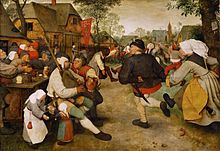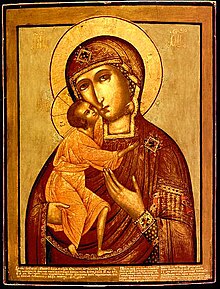Panel painting (painting)

In the fine arts, the pictorial representation on flat, solid material such as wood, clay, metal, ivory is called panel painting . It differs when it comes to wall paneling and colored wooden ceilings from wall painting , which works directly on a mineral base.
Otherwise, when painting wood and other furniture , one generally speaks of panel painting , both when it is a question of ornamentation (decorative painting) as well as when it is intended as independent pictorial elements, such as the altar leaf , or as a picture on a painting board (the board picture in the actual sense, picture "on wood", or wooden board picture ): This is how the pictorial representation on the sheet (the central surface element) of every chiseled or filled work is called a board painting , also with the panel door as a component of the House and also the furniture, as well as the coffered ceiling , and similar decorative, attractive placements.
One does not speak of panel painting - although the techniques are quite related - when it comes to the setting (painting) of , for example, three-dimensional objects such as sculptures and moldings : the flat, two -dimensional image ground is part of the essence of panel painting. Large areas are also part of the character; small-scale painting on solid materials is called miniature painting .
history
Panel painting in classical antiquity began with the Greek pinakes in the 8th to 6th centuries BC. And continued in Byzantine icons in the 5th century .
In Western art, the development of the altarpiece in particular favored the development of panel painting. Their task was initially solely to depict religious motifs in the altarpiece.
While in the 14th century panel painting developed as an independent north of the Alps, wall painting initially remained synonymous in Italy . Since the Renaissance , panel painting, independent of the altarpiece, has been the more prevalent subject. However, it was soon largely superseded by canvas painting : panel painting is subject to limits in terms of the size of the painting surface, even with the progress of the technology of surface-forming wood connections , while the canvas also allows monumental images. On the wall, the wall painting (especially in the fresco technique , but also as technically simpler secco ) was always considered to be more permanent - even when the use of canvas on the wall, wallpaper , and wood paneling began to displace the interior. Only in furniture decoration has panel painting been indispensable up to the 20th century, as well as in special subjects, such as the Orthodox icon.
The painting surface in panel painting is usually provided with a primer or underpainting . A chalk base is also applied to rougher surfaces and especially to working wood . The painting technique used is mainly tempera painting and oil painting , and in younger years acrylic paints .
In many cases, board pictures are provided with a so-called parquet (a grid-like stabilization made of wooden strips) on the back , which let the wood of the board "work" and prevent cracks as much as possible.
example
The Wildunger Altar by Conrad v. Soest is one of the most important works of panel painting.
literature
- Uwe Albrecht (ed.): Corpus of medieval wood sculpture and panel painting in Schleswig-Holstein. Volume 2: Hanseatic City of Lübeck. The churches of the city. Verlag Ludwig, Kiel 2009, ISBN 978-3-933598-76-9 .
- Klaus Krüger: The early image cult of Francis in Italy. Change in shape and function of the panel painting in the 13th and 14th centuries. Berlin 1992.
- Knut Nicolaus: DuMont's handbook of painting. DuMont Literature and Art Publishing, Cologne 2003, ISBN 3-8321-7288-2 .
- Knut Nicolaus: DuMont's image lexicon to identify paintings. DuMont Buchverlag, Cologne 1982, ISBN 3-7701-1243-1 .
Web links
Individual evidence
- ↑ See also: Article Parquet in Peter W. Hartmann: Kunstlexikon , Beyars GmbH, ISBN 978-3-9500612-0-8 .
